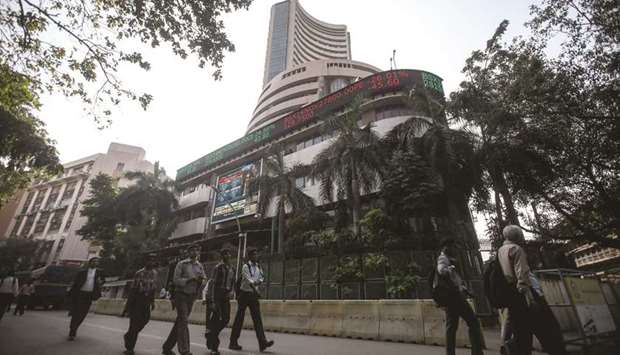Yes Bank sank to the lowest level since 2016 after India’s banking regulator refused to extend the tenure of the lender’s chief executive officer, while Dewan tumbled 43% for its steepest loss on record.
The benchmark S&P BSE Sensex swung from a 1% gain to a drop of as much as 3% – its wildest intraday move in more than four years.
The BSE Sensex closed 279.62 points, or 0.75%, lower at 37,121.22, while the Nifty 50 fell 91.25 points, or 0.81%, to close at 11,143.10 yesterday.
The declines showed that investors remain jittery about Indian financial shares after a recent default by Infrastructure Leasing & Financial Services Ltd shook confidence in the sector.
“IL&FS’ problem and Yes Bank’s issues are impacting every financial stock in the market,” A K Prabhakar, head of research at IDBI Capital Market Services, said by phone. “Leveraged positions are being reduced.”
Dewan Housing has a strong liquidity position and sufficient funds available to service any repayment obligations, Chairman Kapil Wadhawan told Bloomberg in a phone interview. The company has no exposure to to IL&FS Group, Wadhawan said.
DSP Mutual Fund sold Dewan Housing bonds this week to boost its cash holdings before an expected tightening of market liquidity in September, Kalpen Parekh, president of DSP, said in an interview. The firm sold Rs3bn ($41.6mn) of the bonds to express “our interest view, not a credit view,” Parekh said. “This has been done across issuers over last few days.”
Some investors are speculating that the Reserve Bank of India may tighten rules for housing finance firms after a long legacy of shoddy lending that’s resulted in ballooning bad debts. This comes after the central bank said Yes Bank’s chief executive officer will have to step down at the end of January.
“Investors are speculating that more bad loans may come to light as RBI may take stricter action,” said Soumen Chatterjee, head of research at Guiness Securities.
The RBI has also taken a tough line with other private- sector bank CEOs in recent months. The central bank refused to extend the tenure of Axis Bank chief Shikha Sharma, who said she would step down at the end of 2018 despite support from shareholders.
The IL&FS downgrade and default may have nudged investors to avoid potential collateral damage in other financial stocks.
“Downgrades are a serious possibility” for non-bank financial companies, Aneesh Srivastava of IDBI Federal Life Insurance Co said.
After a world-beating advance, the outlook for India’s stock market might be turning amid the financial-industry turmoil. Goldman Sachs Group Inc published a report dated September 16 that called time on the rally and downgraded its stance to the equivalent of a hold rating, citing elevated valuations.
The turbulence in India follows bursts of market volatility across Asian and developing countries this year. While a record-breaking surge in US stocks has kept equity markets largely buoyant, some investors are growing skittish as global interest rates rise.
The Hong Kong dollar posted its biggest swing since 2003 yesterday, while markets from Turkey to Argentina have endured big spikes in volatility in recent months.
“A bearish phase in the market is beginning,” IDBI Federal’s Srivastava said.
Meanwhile the rupee is this year’s worst-performing Asian currency, dropping 11% to set a succession of record lows. It reached an all-time low of 72.9750 per dollar this week before jumping 0.2% yesterday to 72.22.
The currency may eventually strengthen back to 68, according to Shantanu Shukla, a vice president for global markets at India’s biggest bank said, without giving a time frame.
The rupee may be set to recover as oil peaks out and investors realise the currency has been sold off too heavily amid the emerging-market rout, he said.
The currency’s slide this year is also likely to be self-correcting to some extent as its weakness will help boost exports, said Shukla, who works for SBI in Singapore. While part of the rupee’s weakness has stemmed from the US-China trade war, he said this may actually benefit India’s economy as businesses look to source products from alternative markets.
“In the short term, the rupee is suffering from the market sentiment,” Shukla said in an interview this week. “Right now it’s contagion. Everything is being painted with the same brush. I don’t think beyond 70 is a number that the Indian rupee should trade at.”
India’s government has been seeking to stem the selloff, last week announcing a number of measures to stem the rupee’s slide.
These included relaxing overseas borrowing restrictions on local manufacturers, reviewing whether to ease a cap of foreign ownership of corporate bonds, and considering limiting “non-essential imports.”
These efforts have so far failed to halt the currency’s decline as buoyant fuel costs have pushed up India’s import bill and worsened its current-account deficit.
Relief may be in sight on the oil front, Shukla said. The surge in crude will encourage shale producers to re-enter the market, helping to cap the oil price at $80 to $85 per barrel, he said.
The Reserve Bank of India may also tighten policy again to bolster the rupee when it meets next month, he said. The central bank raised interest rates to the highest in two years in August.
The rupee’s recent plunge is evoking memories of slide of around 20% from February to August 2013 during the so- called taper tantrum. India’s fundamentals have improved since then and it has a bigger war chest of foreign-exchange reserves, Shukla said.
“Smart institutional money will come back,” he said. “At some point, this whole fall will be stemmed and we will see money coming back.”



